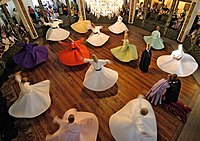Ref Wikipedia
Main article: Spiritual practice
Various religious texts prescribe meditative practices in order to achieve the state of consciousness which is typical of religious experience.[citation needed] Texts of Yoga and Tantra mention specific physical, nutritive, ethical, and meditative methods in order to achieve specific kinds of experiences.[citation needed] The traditions of Mantra Marga (literally, "the way of formulae") in particular stress the importance of saying, either aloud or to oneself internally, particular Mantras (phrases to be repeated) given by their teacher.[39] Combined with this is the set of practices related to Yantras (symbols to be meditated on). Various other ways not specific of any religion include:- Meditation[40]
- Praying [41]
- Music [42]
- Dance, such as:
- Yoga, consisting of postures (Asanas), controlled breathing (Pranayama), and other practices.[27]
- Extreme pain, such as:
- Profound sexual activity,[45]
- Use of Entheogens, such as:
- Ayahuasca (Dimethyltryptamine) [46]
- Salvia divinorum (Salvinorin A) [47]
- Peyote (Mescaline) [48]
- Psilocybe cubensis (Psilocybin) [49]
- Amanita muscaria (Muscimol)[50]
- Cannabis (THC and other compounds) [51]
- Psychological or neurophysiological anomalies, such as:
- Profound depression,[52] bipolar, schizophrenia or other conditions manifesting psychotic spectrum symptoms.[53]
- Temporal lobe epilepsy[54]
- Stroke[55]
- Near-death experience[56]



No comments:
Post a Comment